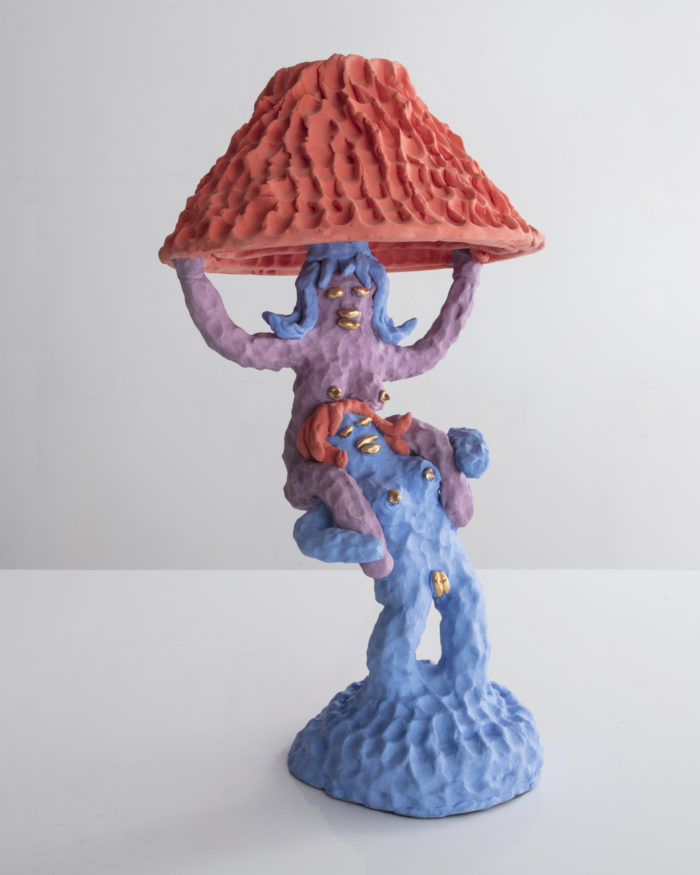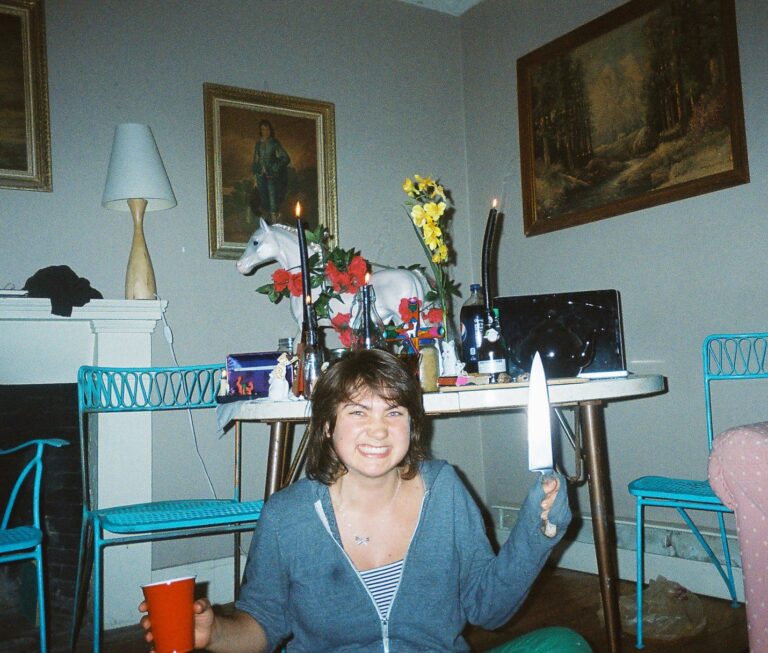
Katie Stout: As I was preparing for this interview, I was trying to remember how it was that we actually met.
Jim Walrod: I had seen your work at Design Miami and really liked it. We met sort of quickly there, but then we got to know each other at Nina Johnson’s house, where she was hosting a party that week where there were far too many famous artists.
KS: That’s right. I remember we hung out a few times after that. Randomly, you kept coming up in conversations that I was having with other people.
JW: I want to ask you about how your upholstered Home Depot chair came about.
KS: I made that as a school project at RISD I had this sweater that I couldn’t fit into and I was adamant about wearing it, and I knew this was never going to work so I made a little stuffed chair out of it. And I liked the idea of, it was sort of like a model of something larger that I wanted to do. And I just liked the idea of this chair that you just can’t sit in, and it’s totally apathetic. Like I don’t really want to be a chair anymore. I’m over it.
JW: Did you know how to formally design while you were at RISD?
KS: Yeah, for sure. There is some stuff over here in the studio, like this chair that is actually so well made, that I did when I was in school.
JW: Where do you want your work to go? Sooner or later you are going to have to put a stick in the ground and ask is this art or is this design?
KS: That’s such a good question. And it’s something that I have been avoiding.
JW: That’s great! You have been afforded the greatest arrested development. Like Gaetano Pesce, he went to formal training and then went into arrested development at like 65, you know. And you can afford that. I always thought that is the best thing that could happen; you get this time when you are out of college that you can take time to learn the art of something, and you can fuck around and hopefully you have a tiny bit of success so that you can pay rent in New York. And it’s kind of like you have had that.

KS: I was recently on a panel discussion and we were talking about the trajectory of art and design and how they are sort of going to coexist and continue a conversation together. Not ‘what’s the difference between art and design,’ but sort of like ‘what is the difference between art and design?’ If I was smarter, I would just say I am an artist. Because of the perceived value of art and also I think it allows more freedom in what you make and how it functions. For instance, with these Girl lamps I don’t think they can technically be UL-certified because the shades are so heavy. So they’re sculptures of lamps. But I also love making things that people can use. I like that people can tell their own stories through these objects. And I don’t think just because it is a piece of furniture it means that it is design, but I think some people are stuck with that notion. I guess I still don’t feel like answering that question.
JW: I don’t think that you should. I mean I think there is no real reason to do it yet, but like the idea of categorizing it and showing it at a gallery that shows furniture is the thing that’s going to maintain context. But if you look back to the ’70s, when Ettore Sottsass went to the offices of Olivetti to design typewriters, there’s historically been this crossing over. I always thought of him being clearly the best example of how you could have art, design and a career. He was doing things that were artistically driven as opposed to industrial design. It’s an interesting thing where people want to talk about this in a dialogue, but in truth it’s whatever you want to call it. I mean I guess if I had to choose I would say it’s art. For sure.
KS: Except the art world is funny in that way too, because they don’t respond to anything that has to do with ‘design as art.’ What are you doing with art? Well, there’s the show in September at R & Company. It’s going to be all girls. Well, there are some boys in it, too… it’s sort of about the objectification of women. That’s part of the reason I have been calling them girls it’s just sort of, I feel like so many people call women girls. It’s really disempowering. So I guess that’s part of the reason why I’m just taking ownership of that in my work, and with that idea in mind I want to explore all of these different materials and sort of work with a bunch of people.
I am really into the idea of designing things and then working with different vendors and sending them drawings and playing like a broken game of telephone. Like incorporating all of these other people into my little experiment. I am doing all of these woven wicker women and these jute rugs that look like sort of like women holding each other and things like that. I just made this giant sofa named Pepita and I am doing like a sleeper sofa of her. Just like extreme objectification. Later on I want to do a La-Z-Boy woman. Just because it is so horrible.
JW: So do you think you’re in a good place where you are shown now with R?
KS: Yea, I love R. They have so many resources, and it’s really nice to work with a gallery that can help me in that way, and that has such a large operation. It provides a lot of security and is super beneficial to my work.
JW: I’ve always been proud of those guys and the nature in the program that they have. They have a vision. There are some beautiful, well-crafted things and then I feel like, erratic. I feel this nuance amongst all these other people on their roster, and I think that’s fun.










 in your life?
in your life?

